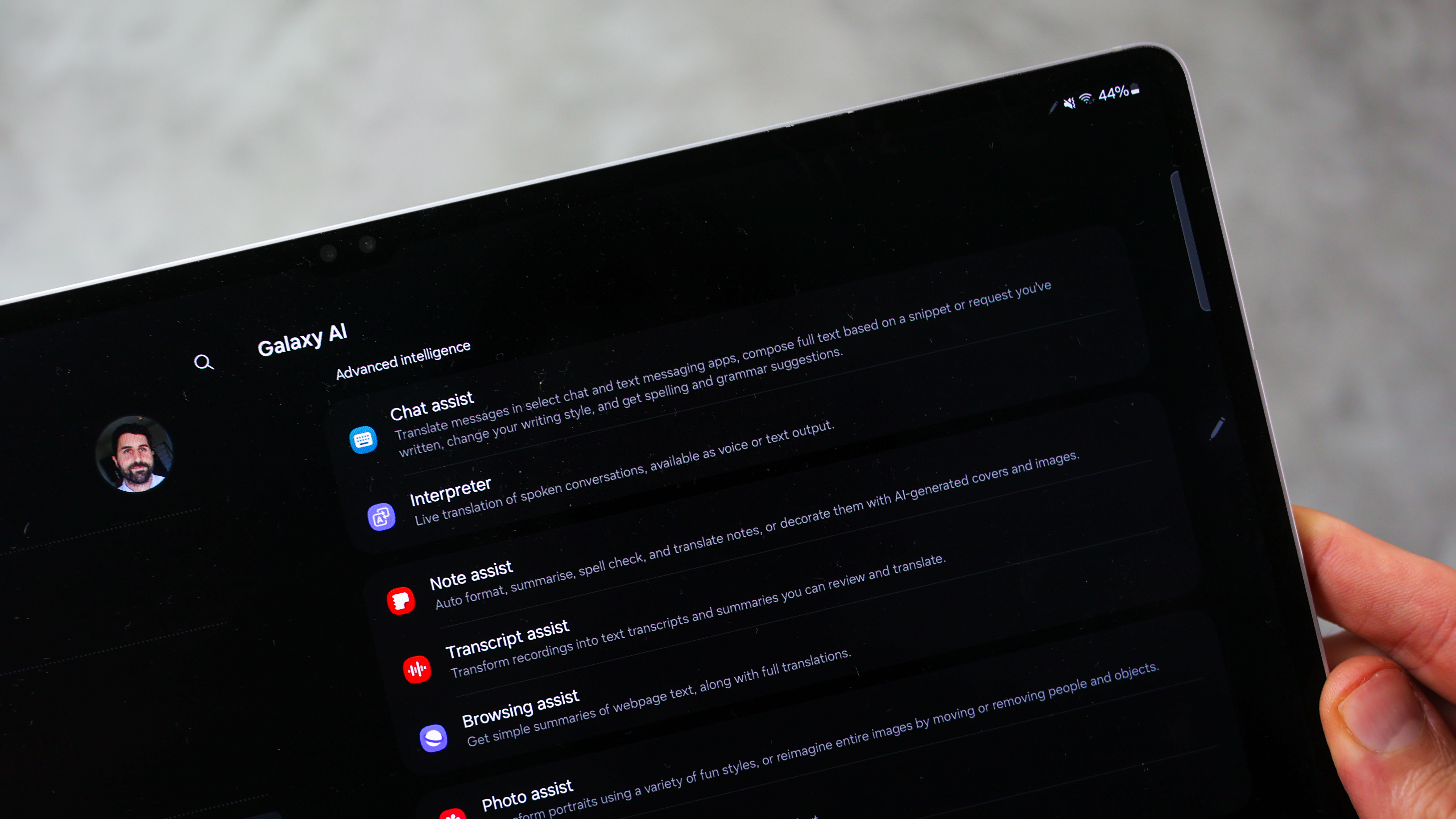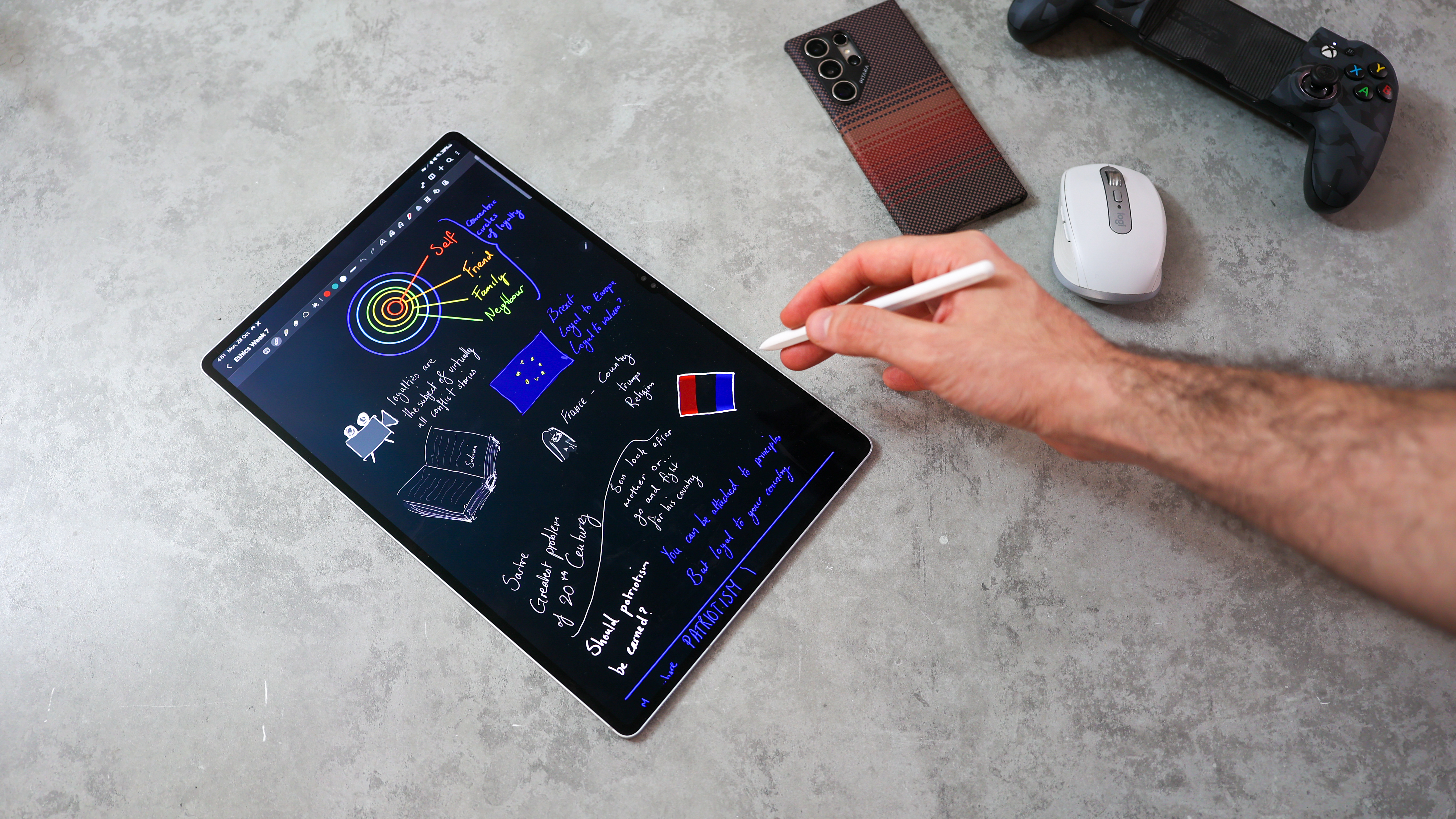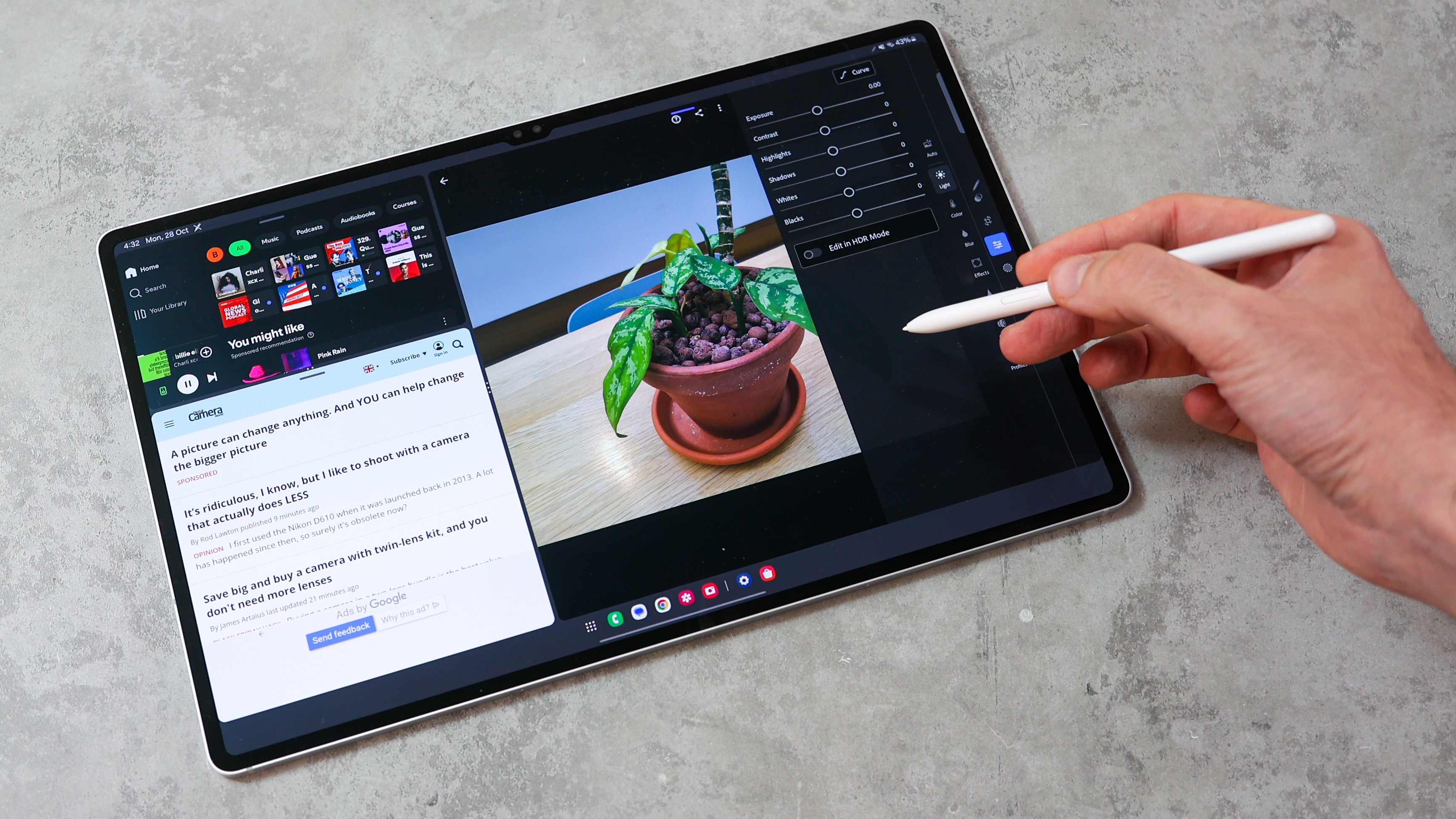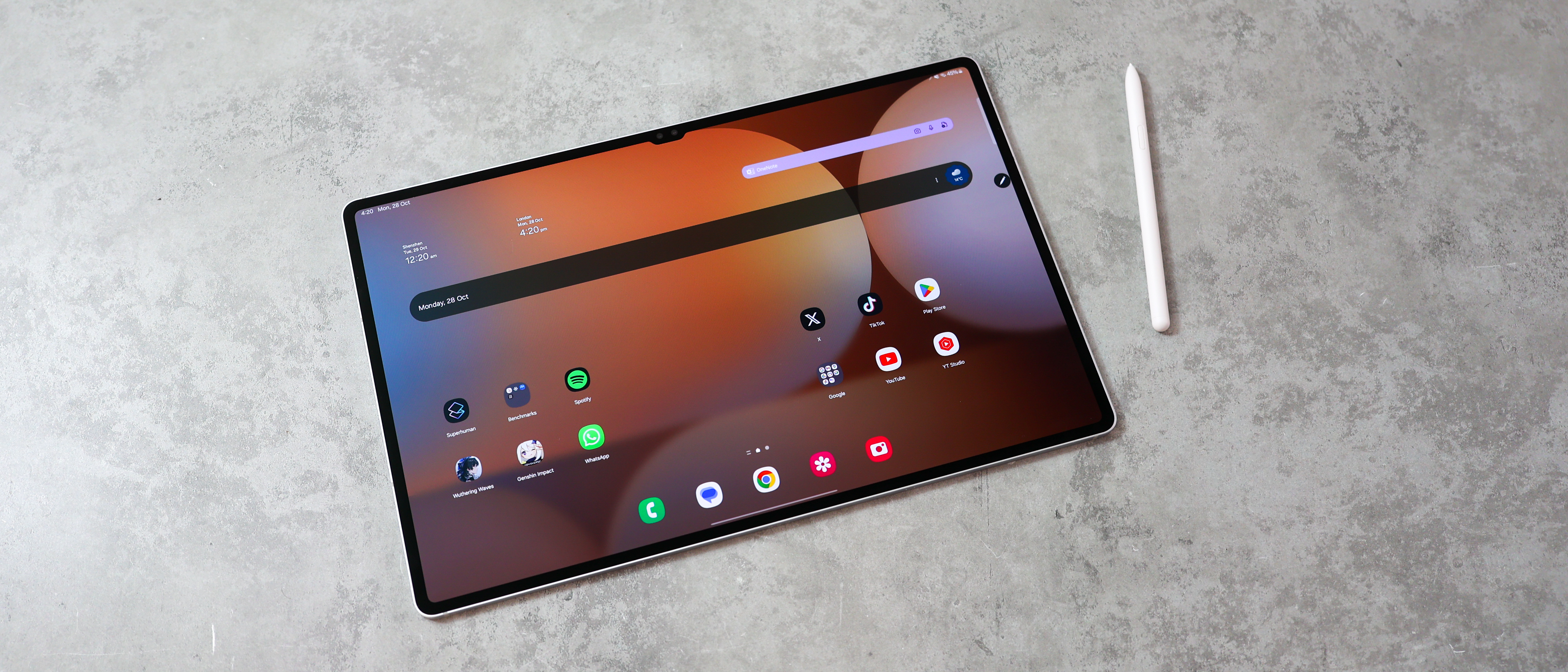Digital Camera World Verdict
The Samsung Galaxy Tab S10 Ultra is an incremental upgrade compared to the S9 Ultra and even the S8 Ultra, but it still has the biggest, best tablet screen on the block for watching widescreen content, which benefits from upgraded outdoor viewing thanks to the anti-reflective panel this year. You get a pressure-sensitive pen in the box, and its IP68 water resistance means the Tab S10 Ultra is a multi-purpose powerhouse. Let down by a mediocre keyboard dock, it isn't our top choice for productivity, but for entertainment, it's a winner.
Pros
- +
The Low-reflection panel is excellent
- +
Vibrant, large, immersive screen
- +
Flagship power and performance
- +
Ultra-thin, premium design
Cons
- -
Very expensive
- -
Arguably too big for most
- -
Less bright than latest iPad Pros
- -
Fewer tablet-optimized apps than iPad
Why you can trust Digital Camera World
The Samsung Galaxy Tab S10 Ultra is a very big-screened, high-end tablet that's perfect for photo edits, pen tasks, and watching widescreen content, but it is a very incremental update.
The Tab S8 Ultra introduced the oversized form factor to the Tab S line, the Tab S9 Ultra added water resistance, and the Tab S10 Ultra upgrades the display. Unless you own a Tab S8 or S9 Ultra and are looking to upgrade, though, that isn't a bad thing.
After all, Samsung's Ultra Tabs are still the go-to oversized premium Android tablets. They combine excellent software, design, and out-of-the-box pen support (ideal for Lightroom). Most of all, Samsung’s premium tablets are known for having the best screens around, also critical for photo edits, a highlight we really appreciated when testing the Tab S8 and S9 Ultra.
With the handful of competing tablets like the Lenovo Tab Extreme now past their prime, and the excellent OnePlus Pad 2 missing out on an OLED display despite packing flagship power, Samsung is still the Ultra-sized tablet maker to beat outside the Apple camp. The question is, should you pay top dollar for the S10 Ultra, or can you get away with spending less on one of its predecessors?
Samsung Galaxy Tab S10 Ultra: Design
To say the Tab S10 Ultra has zero design upgrades isn't quite fair. It's a few grams lighter and 0.1mm thinner than the Tab S9 Ultra at 718g and 5.4mm thin. The tablet may be a waif, but it's still huge thanks to the giant 14.6-inch screen.
The tablet's Gorilla Glass front has also been updated to feature the same anti-reflective quality the flagship Samsung Galaxy S24 Ultra supports, making it the best tablet we've tested in bright environments without having a matte display.
The Tab S10 Ultra's aluminum frame and back create flat sides and curved corners, making it easy to grip and not too sharp as the corners nuzzle into the hand. The heavy weight, however, will make it a bit much for extended one-handed and even two-handed use.
With IP68 water resistance, the Samsung Galaxy Tab S9 Ultra can be submerged in up to 1.5m of water for 30 minutes without fear, and you can write on it using the S Pen underwater.



Dotted around the frame is a quad-speaker system tuned by AKG which sounds immense, an SD card slot, a USB-C port, and the power and volume buttons. The back panel has a dual camera and a magnetic charging point for the S Pen, and on the front is the screen, a notch for the selfie camera, and an under-display fingerprint scanner.
Available in Moonstone Gray and Platinum Silver, we tested the Silver option which fends off fingerprints better thanks to its lighter color.
Just like with the Tab S9 Ultra, the only area the Tab S10 Ultra falls short is accessories. Samsung’s official keyboard folio hasn't been meaningfully updated this year (it shares the same design, is backwards compatible, but now has an AI button), and isn’t particularly comfortable for typing on a lap.
Apple’s Magic Keyboard for iPads and Lenovo’s Tab Extreme keyboard folio are much more fit for purpose. So, if you’re picking up the Tab S10 Ultra for productivity, ensure you do most of your typing at a table or desk.
Samsung Galaxy Tab S10 Ultra: Screen
The Tab S10 Ultra's excellent screen has a peak brightness of around 930 nits when playing back HDR content, though its typical max brightness is nearer 400 nits.
This is nice and bright for a tablet this size, but isn't class-leading, with the new iPad Pro's OLED display taking the crown. While the Tab S10 Ultra doesn't seem to up the brightness, it does improve outdoor viewability thanks to the anti-reflective coating, which is a boon for anyone who plans on using their tablet outdoors.
Just like the Tab S9 Ultra, the S10 Ultra also has a 1848 x 2960 resolution, which equates to a pixel density of 239PPI. With its smooth 120Hz refresh rate, menus glide, and the widescreen 16:10 aspect ratio is a perfect pairing for 16:9 shows, especially when set against much more square iPads and their heavy letterboxing. In fact, watching content is when this slate really shines head and shoulders above the competition.


There's one downside to having such a great, reflection-free screen on the new Tab S10 Ultra: a standard screen protector will add all that reflectivity right back. In turn, you'll want to pick up a non-reflective screen protector if you want to retain one of the few upgrades the Tab S10 Ultra packs over its predecessors.
Our tablet picked up a few micro scratches in our time with it – we didn't have a folio to protect the display – and it also arrived for review with a deep scratch in the glass. This didn't detract from the experience but highlights the point – the tab may be IP68-rated, but it isn't indestructible, so factor in a protective case and a screen protector when you pick it up.
Just like the Tab S9 Ultra, the Tab S10 Ultra has a notch for the two front cameras. This keeps the bezel extremely slim, and falls outside the viewing window for 16:9 content and wider, so we didn’t find it interrupted our view.
Samsung Galaxy Tab S10 Ultra: Camera

The Galaxy Tab S10 Ultra’s cameras are modestly specced, as is the case with most tablet cameras, and there's no change to the hardware when compared to last year's Tab S9 Ultra. In turn, it will probably fit in your photography workflow by providing a display for your primary camera or editing photos captured on your smartphone, but won't be your dedicated camera of choice.
Starting with the camera specs, the Tab S10 Ultra has two on either side. Around the back is a 13MP primary camera and an 8MP ultra-wide. On the front are two 12MP cameras for selfies and video calls. The primary camera is good enough for a document scan and is the only camera on the tab with autofocus, with the rest featuring fixed-focus lenses.
As for the front camera mix, it’s great for video calls – in bright environments, it’s sharp enough for an HD feed – and all the cameras can shoot 4K 30fps video except for the ultra-wide rear camera. Drop the lights, and none of the cameras – front or back – hold up particularly well.
Samsung Galaxy Tab S10 Ultra: Productivity

For 2024, Samsung's smartphones and tablets have been updated with AI features, including Sketch to Image, transcription, translation, and interpreting tools, as well as text generation features, plus Google's Circle to Search.
If you think you need to buy a new Tab S10 Ultra to get Samsung's AI features, the Tab S9 Ultra and S8 Ultra have both been updated to OneUI 6.1.1, which adds all the S10 Ultra's AI smarts.
As part of OneUI – Samsung's interface which sits on top of Android 14 – the Tab S10 Ultra features DeX, Samsung’s desktop UI. This creates a Windows-style desktop interface and takes full advantage of the tablet's oversized display, working especially well when using the S10 Ultra in a keyboard folio or with a keyboard and mouse.
You can also project this desktop experience to a monitor or TV by plugging it in, creating a dual-screen view, with the tablet displaying the standard Android UI.

Samsung's default Android interface isn't without its own multi-tasking strengths, with the taskbar making multi-tasking across three apps in a split-screen view very intuitive. While on smaller tablets and phones like the Galaxy Z Fold 6, this three-app split-screen experience is too cramped, on the giant Tab S10 Ultra, each app is still easy to navigate and has plenty of room to display.
Samsung’s pressure-sensitive S Pen is also a powerful creative tool. Whether using a brush with precision in a drawing app like Concepts or with the Heal tool in Lightroom, the S Pen’s 4,096 levels of pressure sensitivity and almost brush-like feel on-screen has always been a tonic to Apple’s hard plastic Pencil.
The main creative limitation of the Tab S10 Ultra is Android itself, more specifically, app support. While a lot of quality apps are available for it: LumaFusion, GoodNotes, and Concepts, for example, the iPad benefits from DaVinci Resolve, ProCreate, and other specific tools many pros will prefer.

Samsung Galaxy Tab S9 Ultra: Performance
This is the first year Samsung has used a MediaTek chipset in a flagship device, so the Galaxy Tab S10 Ultra is powered by a Dimensity 9300+ matched with 12GB RAM at the starting capacities of 256GB or 512GB or 16GB RAM if you opt for the maxed-out 1TB versions. All three support storage expansion via microSD card.

With its upgraded power, the Tab S10 Ultra does an excellent job of 4K video edits and 3D gaming. Because of its extra size compared to a smartphone, the MediaTek processor has more space to stab cool, so it performs better in the tablet than in any phone we've tested it using. Able to play Wuthering Waves for hours and still keep frame rates around the 60fps mark, and the same for Genshin Impact, with both games' graphics settings maxed out, the tablet also scores almost 2,000,000 in Antutu, a great result for the gaming benchmark.
The interface glides, even when loaded up with multiple apps on-screen or when DeX is projected to an external monitor. It’s very impressive to get into a rhythm with the tablet, smash out a load of work, and realize it was all powered by a skinny slate.

The Tab S10 Ultra can charge a phone in a pinch with its huge 11,200mAh battery – you just need a USB-C to USB-C port. Three hours of gaming and about 20 minutes of additional screen on time will drain the battery by 50 percent, though watching content is much less demanding, and we were able to make it through a 14 hour long flight with a couple of films and episodes played back with about 35% battery remaining. With less intense use, we easily made it through a few days on a single charge.
Samsung Galaxy Tab S9 Ultra: Verdict

Now that the iPad Pro has an OLED display, the Samsung Tab S8 Ultra, S9 Ultra, and now S10 Ultra are less unique and standout. What's more noteworthy is that Apple is beating Samsung at its own game – screen quality – thanks to the brighter tandem OLED display in the iPad Pro.
Where the Tab S10 Ultra edges ahead for 2024 is its screen aspect ratio. Being widescreen, it's much better for watching widescreen content on, looking stunningly immersive with minimal letterboxing for 16:9 and even 20:9/21:9 shows. Samsung's interface and DeX are also more malleable than Apple's iPad OS for multi-tasking and working with external displays, and Android's file management system is less finicky than that of Apple, so the Tab S10 Ultra is arguably a more flexible laptop replacement, especially for Windows users.
Where it loses out to the iPad, though, is its first-party keyboard accessory. Samsung's official keyboard folio isn't easy to use on a lap, and we much prefer using the Apple Magic Keyboard; Android also misses out on apps like DaVinci Resolve and ProCreate, as well as Final Cut and Logic, so some creatives will feel on the back foot switching from an iPad to this.




A final reason you might want to skip the Tab S10 Ultra is the fact it's such a minor upgrade over the Tab S9 Ultra despite being a very pricey one. Yes, the anti-reflective panel is great to have. Still, with no extra brightness, the same display and camera specs, virtually identical designs and UI experiences and battery life, as good as the Tab S10 Ultra is, it's anything but a no-brainer.
So, while the Tab S10 Ultra is the best Android tablet money can buy, anyone happy with a last-gen device could be well served with a lower-cost Tab S9 Ultra or even the two-year-old Tab S8 Ultra.
Basil Kronfli is a freelance technology journalist, consultant, and content creator. He trained in graphic design and started his career at Canon Europe before moving into journalism. Basil is also experienced in video production, independently running the YouTube channel TechEdit, and during his time at Future, he worked alongside the Digital Camera World team as a senior video producer.


